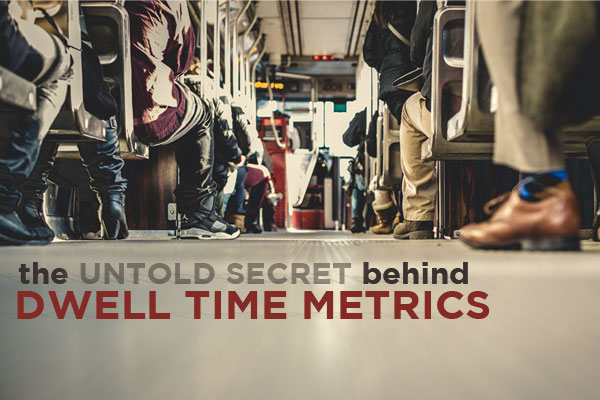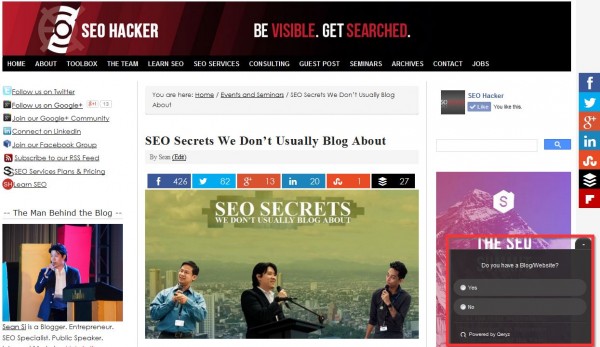The Untold SEO Secret Behind Dwell Time Metrics

There are very few things written about Dwell Time Metrics (A.K.A. User Activity Metrics) as a ranking factor relative to linkbuilding, on-site SEO, and yes, even microdata. Knowing that Google sneaked in the Phantom 2 update (which became known as the “Quality Update“) to their core algorithm right when they launched the highly-awaited, “Mobile-geddon”, this untold SEO secret has become even more important.
If you’re wondering, here’s what the Quality Update is about according to Moz:
[bq1]
The Quality Update — May 3, 2015
After many reports of large-scale ranking changes, originally dubbed “Phantom 2”, Google acknowledged a core algorithm change impacting “quality signals”. This update seems to have had a broad impact, but Google didn’t reveal any specifics about the nature of the signals involved.[bqc]
I’ve always been a fan of Bill Slawski’s knack in unravelling Google’s patents. Because of Bill, all the patent-jargon becomes understandable and makes proper sense in how we do our work as SEO specialists (thanks Bill!).
He wrote one in specific about the “Long Click” and it’s such a coincidence that I was also led to read another article from a long-time SEO specialist that tackled user activity as an indirect, but powerful SEO factor.
What is the “Long Click”?
“On the most basic level, Google could see how satisfied users were. To paraphrase Tolstoy, happy users were all the same. The best sign of their happiness was the “Long Click” — This occurred when someone went to a search result, ideally the top one, and did not return. That meant Google has successfully fulfilled the query.”
– Steven Levy
From that statement, we can easily derive that Google thinks this way:
- If a user clicks on a website, and stays there, does some things, spends some time and then leaves that website fulfilled, that’s a really good thing. We have successfully given the user a relevant result.
- If a user clicks on a website and goes back to Google, it must mean that the website was not able to fulfill the user’s intention and must be re-evaluated. Perhaps we should let another website take its place on the rankings and see if that performs better.
A user who makes a search query in Google, clicks on a site, and goes back to Google to look for another site is more commonly known as “Pogo-Sticking“. Pogo-sticking is not a good thing.
[bq2]The reason behind that is, Google wants users to get what they want – what’s relevant to their search query. If the user doesn’t get it, Google is not doing its job properly. And Google wants to do its job well.[bqc]
This makes the Long Click that much more important. Here’s what Bill said about the importance of the Long Click:
“Your ability to create pages that can end up in a “long click” from someone who has come to your site in response to a query, is also a “search success” metric on the search engine’s part, and you both succeed.”
– Bill Slawski
So if you get Long Clicks for your website from people coming from Google, that makes you, Google and the user happy. It’s an extremely happy situation (yay!)
So how do we make sure that we get the Long Click?
That’s the million-dollar question, isn’t it? There are numerous ways to engage your audience but the Long click doesn’t start with user engagement. No, it starts with your Title Tag and Meta Description because that gets the click-through.
1) Always put a Title Tag that Delivers
A Title tag that ranks is awesome. A title tag that ranks, gets the click and doesn’t deliver what it says it should, is bad for SEO.
For example, if you have a Title tag that says “Free SEO eBook”, it should go to a page that really allows people to download that SEO eBook for free. Otherwise, if you’re asking for any kind of payment, the user would just go back to Google and look for another site that offers a free SEO eBook.
Make sure your Title Tag keeps its promises.
2) Always make sure your Meta Description Reinforces the Title Tag
What your Title Tag is promising, the Meta Description should explain in further detail. Simple as that.
Meta Descriptions allow for a lot more words than what would fit in a Title Tag. Naturally, you’d want all the words that don’t fit into the title tag to pepper your Meta Description.
Okay, so that’s two easy and actionable things for you. But here’s the important part – if you’re ranking on a specific spot in the Search Engine Results Page, you have to get the click-through that your spot merits.
 Image Credit: Marketing Land
Image Credit: Marketing Land
Why?
Simply put, if you don’t get those click-through rates, it means your Title Tag and Meta Description isn’t really all that appealing. It doesn’t really describe what users are looking for when they type in their search query.
So Google will naturally rank you down.
Nasty, right?
Click to Dwell
So now you’ve got an awesome Title Tag and Meta Description ready to haul in the clicks, what do you do next? Next, and this is very important, you make sure that they stay until Google considers their Dwell Time Metrics as a Long Click.
One really easy way to do that is to make sure that unwanted pop-ups and ads are not in the way between your user and their goal in your site – whatever that may be. That almost ensures that the user will bounce off immediately.
90% of the time, the user’s goal in your site can be derived from their click-through. Which means that their goal is derived from your Title Tag and Meta Description.
From the example earlier, this means that if you’re offering a free download of an SEO eBook, you are able to deliver it right away. This prevents pogo-sticking.
However, it doesn’t necessarily increase dwell time metrics. For this reason, you have to engage them further. It could be through thousands of different ways depending on your industry. One way I engage my audience here in SEO Hacker is by showing them a small, unintrusive survey on the lower-right section of the screen.

Yep. That survey has been answered by at least 7,000 people. Most of them coming from Google. Since installing it, our time on page (on a per-page basis) has increased significantly.
You could signup for this survey tool for free here.
One other thing I did in light of this, is to install a Free site Audit tool in our company’s website. This has increased user dwell time for that site.
Wrap-Up
The Long Click is a relatively new patent granted to Google. On top of the phantom, “Quality Update” core ranking algorithm, I can only guess on how important this will turn out to be over time. Connecting your SERP snippet’s promises (Title Tag + Meta Description) -> to your user’s experience (Anti-Pogo-Sticking) -> to an increased Dwell Time (Engagement) may take a lot of work depending on the scale of keywords you’re trying to hit.
Oh well…
At least it’s a lot more concrete than linkbuilding.


